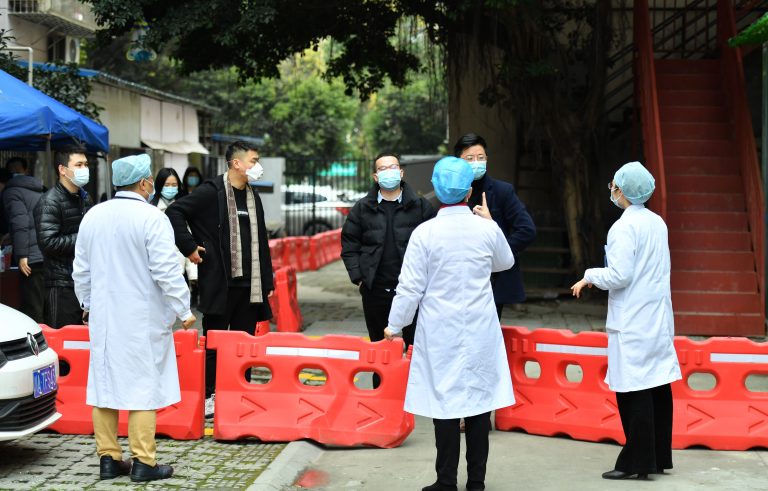On July 28, Sichuan Province, located in southwest China, announced a state of an emergency in response to a suspected COVID outbreak, asking to upgrade epidemic prevention and control measures. All people entering the province were required to cooperate with a 14-day centralized quarantine followed by a 7-day home quarantine.
The Chengdu Municipal Health Commission of Sichuan Province, announced that on July 28, 2021, three new cases were confirmed in Chengdu. The infected individuals were a family of three. However, the lack of transparency regarding the data released by the Chinese authorities was widely questioned by the public.
Immediately afterwards, the local state-run media in Chengdu published an article asking the public “not to believe in rumors, not to spread rumors, and not to create rumors.”
From Nanjing to five provinces
Previously, the focus of China’s pandemic control was Nanjing city of Jiangsu Province. From July 20to July 27, a total of 153 confirmed cases were reported by the authorities in Nanjing. The outbreak in Nanjing started at Nanjing Lukou International Airport. Since July 20, the outbreak has spread to more than 10 localities in five provinces, including Jiangsu, Anhui, Guangdong, Sichuan and Liaoning.
Nanjing government announced on July 27that the strain currently causing the outbreak is a Delta mutant strain. Ding Jie, deputy director of the Nanjing CDC, said the outbreak is highly transmissible and spreading rapidly. A video showed that the Nanjing government is using 240 excavators to level a hill. This led many to suspect that it was an action to construct a “Fangcang” hospital, a name used to describe the makeshift field facilities used to host large numbers of patients infected by the COVID-19 virus during the early months of the pandemic in Wuhan. Government officials vehemently denied such speculation.
Success
You are now signed up for our newsletter
Success
Check your email to complete sign up
On July 28, officials in Suzhou city of Jiangsu Province ordered a full suspension of long distance coach lines to Nanjing, including those merely passing through the city. In the meantime tourist charter buses are not allowed to pick up or drop off passengers in Nanjing. The authority also put a hold on rental car and online taxi services in and out of Nanjing. A total of 2,320 retail pharmacies in the city were prohibited to sell four categories of drugs, including antipyretic, cough control, antiviral and antibiotic drugs.
As the outbreak in Nanjing continues, new cases in other regions appeared to increase. The official notifications from various provinces disclose those cases associated with Nanjing with firm language, whilst keeping the language on the number of cases unrelated to Nanjing. For example, Sichuan, Anhui (a province in central China), and Liaoning (a province in Northeast China), all attempted to blame Nanjing for the outbreaks that occurred in their region.
Some analysts have suggested that outbreaks in other provinces may not have been caused by spreaders from Nanjing’s outbreak. Instead, because the Nanjing outbreak happened earlier, other provincial governments used Nanjing as a scapegoat for all cases occurring in their own regions.
Massive testing and food shortages
In Sichuan, an incognito citizen journalist found that Dongpo Road of Qingyang District was been closed off. This neighborhood was where the suspected infected person lives.Its surrounding area has been under tight security control too.
One young woman reported being prevented from returning home after she went on a jog because she had the misfortune of living in a zone designated for lockdown by the authorities.
Local police said that the district permit coming in not going out, as it has been determined that there are suspected cases of COVID.In the meantime all Chengdu citizens were asked to start receive COVID-19 nucleic acid testing overnight.
A large number of people were waiting in line for nucleic acid testing at Uppercut Road Plaza. A number of people in line said they were notified that there were suspected cases. The notice required that all mall personnel not to leave the plaza after work and must undergo nucleic acid testing, at that time, those who had already gone home were also called back for testing.
One man on the street said via his video clips: “there are too many people waiting for nucleic acid testing. The line is at least 2 kilometers or more. Have to wait for few hours.”
In other cities in Sichuan, such as Mianyang, a third round of mass nucleic acid testing was on going on July 28.
Due to the sudden outbreak in Chengdu, Sichuan, fear for food shortages has increased. This is partially because many did not believe the government’s information about the scale of the outbreaks or nature of the coming lockdown. People have been buying up all vegetables and meat from supermarkets in a short time. There were few vegetables left in the market stalls and hardly a piece of meat in the butcher stores. One person said via his own video: “All sold out, there is no meat left.”
Three steps of control, a China model
The Sichuan authority announced state of emergency to divide the area into four layers of prevention control: quarantine area, controlled area, surrounding area with risk, and other areas. COVID testing would be provided first to quarantine areas, controlled areas, and then other zones.
In quarantine area, a fully closed management approach is implemented and no one would be allowed to leave the house; Controlled area only allows personnel to come in, but no exit. Activity deemed essential is allowed, however gathering is strictly prohibited; in surrounding areas with risk all kinds of large-scale activities, theaters, dance halls, game halls and other leisure and entertainment places will all be suspended.
The model of the Chengdu pandemic control includes road closure, community closure and centralized testing. These three steps are in fact the core content of China’s pandemic prevention and control.














